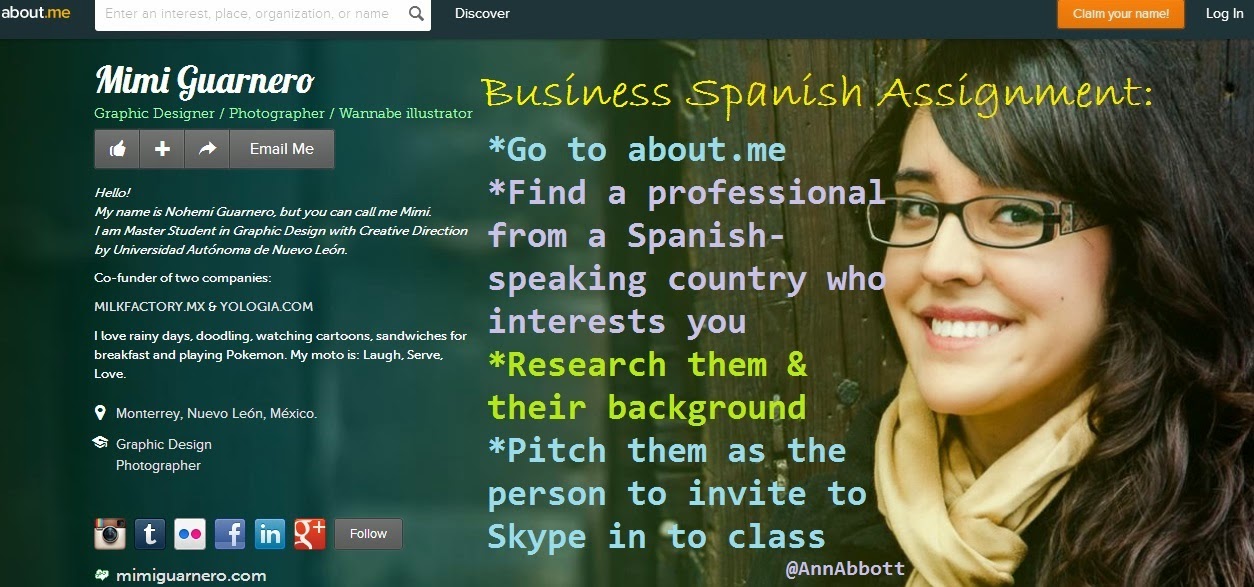Incorporating Authentic Sources and Businesses into Business Spanish Classes
 |
| Let's make Business Spanish real. |
All too often, students' work in Business Spanish centers around fictions. Students write business plans for fictional businesses that they will probably never launch. Business cases highlight real-life issues but often within the context of fictionalized characters and companies. The chapter on marketing culminates in students preparing ads that are built on some sort of fictional "Mad Men" fantasy world.
We can do better than that. We can engage our students in real business practices, with real business people.
My Business Spanish class meets Mondays, Wednesdays and Fridays. I'm going to divide the course into three parts:
1. Case studies. Some will come from the textbook, Exito comercial. Others will come from the University of Colorado, Denver's language case studies.
2. Consulting. I did this for the first time last year. My students had five consulting clients and each team of students had to do the social media marketing for their client. They learned a lot! They learned about contracts, meetings, aligning expectations, teamwork, and I hope they learned something about themselves, too. But five clients was really too much. The biggest problem I encountered was this: the kind of communicative competence we expect from students in class (not perfect, just comprehensible), is at odds with the grammatical perfection required when you are representing someone's brand on social media. So we will have just one client this semester: La Linea.
3. Project-based learning. I want students to see and study real-life people from Spanish-speaking countries who are in the business world. I also want them to see that "the business world" doesn't just mean multinationals and billionaires, like Carlos Slim. So, just like the image at the top of this post states, I'll have students do this:
*Use online sites (About.Me, LinkedIn, and others) to search for Spanish-speaking professionals.
Example: Mimi Guarnero is a wonderful example of a young woman from Mexico who has an interesting educational background and a strong entrepreneurial streak. I also want to show students this list of YouTube stars. It features several people from Spanish-speaking countries. I want them to see that "business" can take many forms, including digital communication and entertainment. Furthermore, this specific list shows that the Internet is not "English-only," and that students should use their Spanish skills to explore parts of the Internet that probably don't appear on their Google searches and other highly-filtered sites.
*Find one professional who interests you.
Students might be attracted to a certain city or region. They might be interested in certain careers. Maybe they want to find someone who graduated from the University of Illinois. Whatever the personal connection might be, I want them to pick someone who resonates with them on a personal level and then do research about them. Click on all the links. Google them to find out more. Explore maps and Flickr images about the place they are from. Go all out.
*Pitch that person as someone we should invite to Skype into class with us.
I'll teach the students a formula for preparing an effective elevator pitch (3 minutes; or maybe even this 30-second model of an elevator pitch), then have them all give their pitch during class. Students will then vote on the top three. Working together as a class, we will then contact those three people and see if they can Skype into our class and talk to us about their business experiences.
I'll fill you in with more details as I progress. Do you have any advice? Any concerns? Let me know in the comments!



Authentic, real & motivating! Great ideas on how to connect students with real business people they can look up to and with whom they can have conversations to ask real questions about their careers, successes and challenges. Thanks for this great post, Ann!
ReplyDeleteAuthentic, real & motivating! Great ideas on how to connect students with real business people they can look up to and with whom they can have conversations to ask real questions about their careers, successes and challenges. Thanks for this great post, Ann!
ReplyDeleteLearn Spanish Classes Online and know
ReplyDeleteHow to learn spanish language and
Prepare for DELE Exam